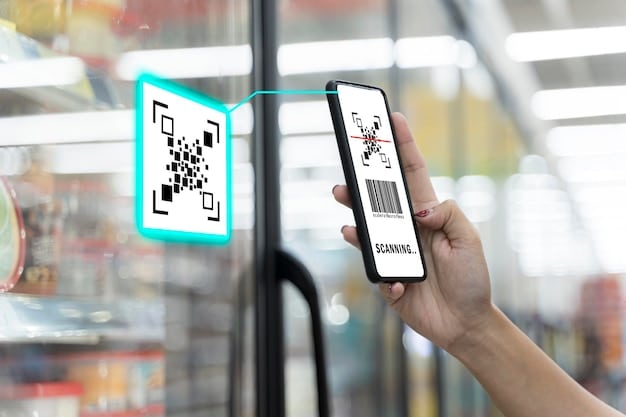Blockchain’s Impact on US Supply Chain Management: 3-Year Outlook

The advent of blockchain technology is poised to revolutionize US supply chain management over the next three years, enhancing transparency, traceability, and efficiency while mitigating risks and fraud across complex networks.
The landscape of global commerce is perpetually evolving, driven by unprecedented technological advancements. One such innovation, The Impact of Blockchain on US Supply Chain Management: A 3-Year Outlook, is rapidly emerging as a transformative force. This technology promises to redefine how goods move from production to consumption, offering solutions to long-standing challenges in visibility, trust, and operational efficiency within the intricate US supply chain.
The Foundations of Blockchain in Supply Chain
Blockchain, at its core, is a decentralized, distributed ledger system. It records transactions in blocks that are cryptographically linked together, forming an immutable chain. This inherent immutability and transparency make it uniquely suited for enhancing the reliability and efficiency of supply chains.
Unlike traditional centralized systems where data is stored by a single entity, blockchain distributes data across multiple participants in a network. Each participant maintains a copy of the ledger, and any new transaction must be validated by the network before being added. This consensus mechanism dramatically reduces the risk of fraud, errors, and data manipulation.
Core Principles and Benefits
Understanding the fundamental principles of blockchain is crucial to grasping its impact. The technology offers several distinct advantages that address common pain points in supply chain management.
- Transparency: All participants in the network have access to the same, verified information, creating a single source of truth for goods, transactions, and events.
- Traceability: Products can be tracked from origin to destination, providing detailed historical data that can be invaluable for recalls, quality control, and compliance.
- Immutability: Once a transaction is recorded on the blockchain, it cannot be altered or deleted. This ensures data integrity and builds trust among stakeholders.
- Security: The cryptographic nature of blockchain makes it highly resistant to cyberattacks and unauthorized access, protecting sensitive supply chain data.
These principles translate directly into tangible benefits for the US supply chain. For example, improved traceability can help combat counterfeit goods, leading to safer products for consumers and stronger brand protection for manufacturers. Enhanced transparency can foster greater collaboration among supply chain partners, streamlining processes and reducing delays. The secure nature of blockchain also means less vulnerability to data breaches, a growing concern in an increasingly digital world. As industries look towards 2025, these foundational benefits lay the groundwork for significant operational improvements.
Current State of US Supply Chain Management
Before delving into blockchain’s future, it’s essential to understand the current complexities and vulnerabilities of the US supply chain. It is a vast and sophisticated network, encompassing everything from raw material extraction to manufacturing, distribution, and retail, serving a diverse and demanding consumer base.
Despite its sophistication, the US supply chain faces numerous challenges that impact its efficiency, resilience, and cost-effectiveness. These issues range from fragmented data systems and a lack of real-time visibility to susceptibility to disruptions and the persistent threat of counterfeit goods.
Persistent Challenges and Vulnerabilities
Several key areas highlight the current limitations and the urgent need for innovation within the US supply chain framework.
- Lack of End-to-End Visibility: Many companies struggle to gain comprehensive, real-time insights into the entire journey of their products. This visibility gap makes it difficult to pinpoint bottlenecks, manage inventory effectively, and respond quickly to disruptions.
- Data Silos and Incompatibility: Different parties in the supply chain often use disparate systems that don’t communicate efficiently. This leads to fragmented data, manual processes, and delays in information exchange, impeding seamless operations.
- Vulnerability to Disruptions: Recent global events have starkly exposed the fragility of global supply chains. Geopolitical tensions, natural disasters, and pandemics can severely impact production, transportation, and delivery, causing widespread economic ripples.
- Counterfeiting and Fraud: The US market is heavily impacted by counterfeit goods, leading to significant financial losses for businesses and posing serious health and safety risks for consumers. Tracing the origin of products effectively remains a major challenge.
These challenges underscore why the US supply chain is ripe for innovation. The existing infrastructure, while robust in many aspects, often lacks the agility and resilience needed to navigate an increasingly complex and unpredictable global market. The traditional model, built on sequential handoffs and fragmented data, struggles to offer the necessary transparency and responsiveness. This sets the stage for technologies like blockchain to provide much-needed solutions, offering a new paradigm for managing goods and information across complex networks.
Blockchain’s Transformative Role: A 3-Year Outlook (2025-2028)
As we look towards the next three years, blockchain’s role in US supply chain management is expected to transition from exploratory pilot programs to more widespread adoption, particularly in specific sectors. This period will be characterized by increased investment, the development of industry standards, and a clearer understanding of the technology’s scalable applications.
The initial focus will likely be on high-value goods, perishable items, and sectors with stringent regulatory requirements, where the benefits of traceability and transparency offer immediate and significant returns on investment. Pharmaceuticals, food and beverage, and electronics are poised to lead this charge.

Enhanced Traceability and Compliance
One of the most immediate and tangible impacts of blockchain will be the dramatic improvement in end-to-end traceability. By 2028, we anticipate that:
- Real-Time Tracking: Products will be tracked in near real-time, from raw material sourcing to delivery, with each touchpoint recorded on an immutable ledger. This will enable precise location data and condition monitoring (e.g., temperature for perishables).
- Automated Compliance: Regulatory compliance will be significantly streamlined. Blockchain can automate the verification of origins, certifications, and quality control processes, reducing manual paperwork and the risk of non-compliance.
- Recall Efficiency: In the event of a product recall, affected batches can be identified and isolated with unparalleled speed and accuracy, minimizing financial losses and protecting public safety.
Beyond basic tracking, this enhanced traceability will empower consumers with more information about the products they buy, fostering greater trust in brands. Businesses, in turn, will gain insights into their supply chain partners’ performance and ethical practices, leading to more sustainable and responsible sourcing. This level of granular visibility is currently aspirational for many companies, but blockchain is poised to make it a reality within the next few years.
Improved Efficiency and Cost Reduction
The operational efficiencies derived from blockchain implementation will translate into considerable cost savings across the US supply chain. The elimination of intermediaries, reduction in errors, and automation of manual processes are key drivers.
- Reduced Paperwork and Administrative Overheads: Digital, immutable records on the blockchain will significantly reduce the need for paper documentation, saving time, storage, and administrative costs.
- Optimized Inventory Management: Real-time visibility into inventory levels across the supply chain will enable more accurate forecasting, reducing overstocking, stockouts, and associated carrying costs.
- Faster Dispute Resolution: With a transparent and unalterable record of all transactions, disputes between supply chain partners regarding shipments, payments, or product conditions can be resolved far more quickly and equitably.
Furthermore, the ability to automate payments via smart contracts, which execute automatically when predetermined conditions are met, will accelerate financial flows, freeing up capital and improving liquidity within the supply chain ecosystem. This move towards greater automation and data-driven decision-making will unlock efficiencies that were previously unattainable, directly impacting the bottom line for businesses of all sizes.
Challenges and Adoption Hurdles
While the benefits of blockchain in supply chain management are compelling, its widespread adoption in the US is not without significant challenges. These hurdles encompass technological, organizational, and regulatory aspects that need to be addressed for scalable implementation.
Successfully navigating these complexities will determine the pace and extent of blockchain integration over the next three years. It requires a collaborative effort from industry leaders, technology providers, and policymakers to establish interoperable standards and address concerns around data privacy and governance.
Key Obstacles to Overcome
- Scalability and Speed: Current blockchain networks, particularly public ones, can face limitations in processing high volumes of transactions at the speed required by large-scale supply chains. Private or permissioned blockchains offer solutions, but optimizing performance remains crucial.
- Interoperability: One of the biggest challenges is ensuring that different blockchain platforms and existing legacy systems can communicate and exchange data seamlessly. A fragmented blockchain landscape would hinder its full potential.
- High Initial Investment: Implementing blockchain technology requires substantial upfront investment in infrastructure, software development, and the training of personnel. This can be a barrier for smaller and medium-sized enterprises (SMEs).
- Data Privacy Concerns: While blockchain offers transparency, sensitive commercial data needs to be protected. Balancing transparency with privacy, especially with GDPR and CCPA regulations, is a complex task that requires careful architectural design.
- Lack of Standardized Protocols: The absence of universal industry standards for how blockchain should be applied in supply chains can lead to disparate implementations, making collaboration and data sharing difficult.
- Organizational Change Management: Adopting blockchain necessitates significant shifts in how businesses operate, requiring workforce training, process re-engineering, and a cultural embrace of new technologies. Resistance to change can slow down adoption.
Overcoming these challenges will require continuous innovation, strategic partnerships, and a clear regulatory framework. The US government and industry consortia will play a critical role in fostering an environment conducive to blockchain adoption, perhaps through pilot programs, grants, and the establishment of best practices. Educating stakeholders about the long-term benefits will also be key to justifying the initial investment and navigating the inevitable complexities of digital transformation.
Industry-Specific Applications and Case Studies
The applicability of blockchain in US supply chains is broad, with several industries standing to gain immensely from its capabilities. The next three years will see an increase in targeted, industry-specific implementations, moving beyond general concepts to concrete, measurable benefits.
Each sector brings unique challenges that blockchain can address, ranging from product authenticity in luxury goods to cold chain integrity in pharmaceuticals. Early adopters are already demonstrating the potential, setting precedents for wider industry uptake.

Key Sectoral Implementations by 2028
- Pharmaceuticals: Blockchain can address drug counterfeiting and ensure compliance with regulations like the Drug Supply Chain Security Act (DSCSA). It provides an immutable record of a drug’s journey from manufacturer to patient, guaranteeing authenticity, proper handling, and efficient recall management. Companies like Pfizer and IBM have been exploring blockchain for drug traceability.
- Food and Beverage: For perishables, blockchain offers unparalleled traceability from farm to fork. It can track the origin, processing, and transportation conditions of food products, crucial for food safety, quality control, and reducing waste. Walmart’s partnership with IBM Food Trust is a prime example, significantly reducing the time to trace food origins from weeks to seconds.
- Automotive: Blockchain can improve the transparency and security of the automotive supply chain, from sourcing raw materials for components to tracking vehicle parts for maintenance and recall purposes. It can also help verify the authenticity of parts, combating the issue of counterfeit components.
- Retail and Luxury Goods: Battling counterfeits and ensuring ethical sourcing are major concerns. Blockchain provides a verifiable digital passport for high-value goods, confirming their authenticity, origin, and ownership history, building consumer trust and brand value.
- Logistics and Shipping: Smart contracts on a blockchain can automate processes like invoicing, customs clearance, and demurrage payments, reducing administrative overheads and accelerating cargo movement. Companies like Maersk and IBM’s TradeLens platform are pioneering this space.
These examples illustrate that blockchain is not a one-size-fits-all solution but rather a versatile technology that can be tailored to meet specific industry needs. The success of these early applications will likely spur further investment and innovation, demonstrating the tangible benefits and paving the way for broader adoption across the diverse landscape of US supply chains. The next three years will be critical in showcasing these real-world transformations, validating blockchain’s potential and solidifying its position as a vital tool for modern supply chain management.
The Future of Supply Chain Resilience with Blockchain
Beyond efficiency and traceability, blockchain holds immense promise for enhancing the overall resilience of US supply chains. The recent past has highlighted the critical need for supply chains to absorb shocks, adapt quickly, and recover efficiently from disruptions. Blockchain contributes to this resilience by fostering greater transparency, enabling proactive risk management, and facilitating rapid response mechanisms.
A resilient supply chain is one that can withstand unforeseen challenges without crippling its operations. Blockchain, with its distributed and immutable nature, offers a robust framework for building such resilience into the very fabric of how goods and information flow.
Building Tougher Supply Chains
- Early Warning Systems: By providing a shared, real-time ledger of events, blockchain can help identify potential disruptions sooner. For instance, if a critical supplier’s production status changes, all relevant parties on the blockchain can be immediately alerted, allowing for proactive contingency planning.
- Diversification and Supplier Trust: Blockchain can help companies vet and onboard new suppliers more efficiently by providing verifiable data on their history, certifications, and performance. This enables a more diversified and resilient supplier base, reducing reliance on single points of failure.
- Enhanced Collaboration and Information Sharing: In times of crisis, seamless communication and data sharing among supply chain partners are paramount. Blockchain provides a secure and trusted platform for this, ensuring that all parties are working from the same, accurate information, enabling coordinated responses.
- Dynamic Rerouting and Logistics: With greater transparency into inventory and transportation networks, companies can leverage blockchain data to dynamically reroute shipments or reallocate resources in response to disruptions, minimizing delays and maintaining continuity.
The ability of blockchain to provide an auditable, single source of truth mitigates the information asymmetry that often exacerbates the impact of disruptions. By fostering a more interconnected, informed, and agile ecosystem, blockchain empowers supply chain stakeholders to not only react to crises more effectively but also to anticipate and mitigate risks before they escalate. This focus on resilience will be a defining aspect of blockchain’s application in the US supply chain over the coming years, transforming it from a fragile chain into a robust, interconnected network capable of enduring future uncertainties.
| Key Aspect | Brief Description |
|---|---|
| 🔗 Enhanced Traceability | Immutable record for real-time tracking from origin to consumer. |
| 💰 Cost Savings | Reduction in paperwork, optimized inventory, faster dispute resolution. |
| 🛡️ Increased Security | Combat counterfeiting and enhance data protection against cyber threats. |
| ⚡ Greater Resilience | Proactive risk management and faster recovery from disruptions. |
FAQs about Blockchain in US Supply Chains
Blockchain in supply chains refers to a decentralized, distributed ledger that securely records every transaction and movement of goods. This creates an unchangeable, transparent history of a product from its origin to the end consumer, enhancing trust and efficiency across the entire logistics chain by providing a single, verifiable source of truth for all participants.
Blockchain enhances transparency by allowing all authorized participants in the supply chain to access the same, real-time shared ledger. This means every step, from manufacturing to delivery, is recorded and visible to all parties, reducing information asymmetry and fostering greater accountability among suppliers, manufacturers, and distributors, which minimizes disputes and boosts collaboration.
Key challenges include difficulties with system interoperability, ensuring data privacy on a transparent ledger, the high initial investment required for implementation, and the need for standardized protocols across diverse industries. Overcoming these hurdles demands significant collaboration among stakeholders and tailored solutions to fit specific industry demands and existing legacy systems.
Industries dealing with high-value goods, perishable items, or strict regulatory requirements are prime candidates for rapid blockchain adoption. This includes pharmaceuticals, food and beverage, and electronics, where traceability, anti-counterfeiting measures, and compliance are paramount. The automotive and luxury goods sectors are also expected to see significant blockchain integration due to similar needs.
Yes, blockchain significantly contributes to preventing and mitigating supply chain disruptions. Its real-time data transparency can act as an early warning system, alerting stakeholders to potential issues. Furthermore, by improving supplier vetting, diversifying sourcing options, and enabling rapid, coordinated responses through shared information, blockchain builds more resilient supply chains capable of adapting to unforeseen challenges effectively.
Conclusion
The journey of blockchain in US supply chain management over the next three years promises to be one of profound transformation. While undoubtedly facing adoption hurdles such as scalability, interoperability, and the need for significant initial investment, the compelling benefits it offers in transparency, traceability, efficiency, and resilience are too significant to ignore. From combating counterfeits in pharmaceuticals to ensuring food safety from farm to fork, blockchain is poised to redefine industry standards and elevate consumer trust. As businesses continue to navigate an increasingly complex and unpredictable global landscape, embracing this technology will not merely be an advantage but a fundamental requisite for building the secure, agile, and resilient supply chains of the future.





